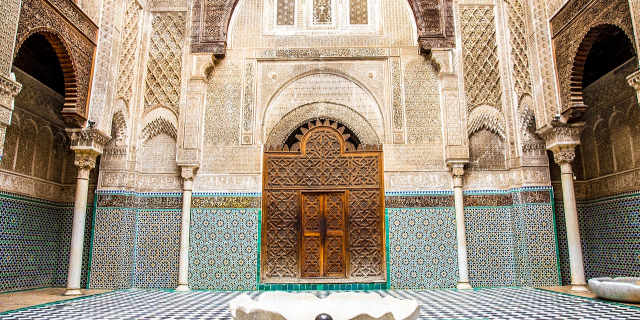Funduq al-Najjarin (Arabic: فندق النجارين, lit. 'Inn of the carpenters'; also transliterated as Fondouk el-Nejjarine) is a historic funduq (a caravanserai or traditional inn) in Fes el Bali, the old medina quarter in the city of Fez, Morocco.
The funduq is situated in the heart of the medina, at Al-Najjarin Square (also: Nejjarine Square or Place Nejjarine), which is also notable for the Nejjarine Fountain, an attached saqayya or traditional public fountain. The building was designed for use by the merchants, traders, and visitors to the city of Fez and provided a storage place. Along with the fountains, the building forms one of the most remarkable urban architectural complexes in historic Fez. Today it houses a private museum, Le Musée Nejjarine des Arts et Métiers du Bois (Nejjarine Museum of Wooden Arts & Crafts).
 Place an-Nejjarine today, with the funduq on the left and the fountain on the right
Place an-Nejjarine today, with the funduq on the left and the fountain on the rightThe name al-Najjarin (or the French transliteration Nejjarine, from Arabic: النجارين) means "carpenters", a reference to the historic presence of a carpenters' souq (market) around the square in front of the funduq today.[1] The souq is believed to have existed since the Marinid era (1244-1465 CE).[2]
The funduq was commissioned by the amin (provost or magistrate) 'Adiyil in 1711, under the reign of the 'Alawi sultan Ismail Ibn Sharif.[3][1][4][5] Another funduq founded in the same year (1711), the Funduq Sagha (Arabic: فندق الصاغة, lit. 'inn of the goldsmiths') in northern Fes el-Bali, also exhibits a very similar architecture and decorative style.[2] The saqayya (fountain) attached to the Funduq al-Najjarin was commissioned in the 19th century by the Sultan Abd al-Rahman (ruled 1822–1859).[1]
Despite these developments from different dates, the various structures and the public square form an integrated whole in the local community. The building was originally used as a trading center, caravanserai (inn), and merchant warehouse associated closely with the Makhzen (the government or royal authorities).[3][4] It likely continued to serve this function up until the beginning of the 20th century.[2] Prior to colonial rule, a small number of rooms in the establishment were owned by some of the city's Jewish merchants.[6] By the 19th century, a post office for the city of Fez also existed between the funduq and the fountain, operating out of a small shop.[7]
The funduq was classified as a national historic monument in 1916 and was used as a police station by the French colonial authority in the 1940s.[3] The building was restored between 1990 and 1996, and on May 23, 1998, it was reopened as a private museum for wood arts and crafts known as Le Musée Nejjarine des Arts et Métiers du Bois.[1][5][3]

































Add new comment